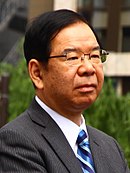
Back Eleccions a la Cambra de Consellers del Japó de 2019 Catalan Sangiin-Wahl 2019 German Ιαπωνικές εκλογές Άνω Βουλής (2019) Greek Elección de la Cámara de Consejeros de Japón de 2019 Spanish Élections à la Chambre des conseillers du Japon de 2019 French 第25回参議院議員通常選挙 Japanese 제25회 일본 참의원 의원 통상선거 Korean 2019 Japonya Danışmanlar Meclisi seçimleri Turkish 第25屆日本參議院議員通常選舉 Chinese
| |||||||||||||||||||||||||||||||||||||||||||||||||||||||||||||||||||||||||||||||||||||||||||||
124 of the 245 seats in the House of Councillors 123 seats needed for a majority | |||||||||||||||||||||||||||||||||||||||||||||||||||||||||||||||||||||||||||||||||||||||||||||
|---|---|---|---|---|---|---|---|---|---|---|---|---|---|---|---|---|---|---|---|---|---|---|---|---|---|---|---|---|---|---|---|---|---|---|---|---|---|---|---|---|---|---|---|---|---|---|---|---|---|---|---|---|---|---|---|---|---|---|---|---|---|---|---|---|---|---|---|---|---|---|---|---|---|---|---|---|---|---|---|---|---|---|---|---|---|---|---|---|---|---|---|---|---|
| Turnout | 48.80% ( 48.79% ( | ||||||||||||||||||||||||||||||||||||||||||||||||||||||||||||||||||||||||||||||||||||||||||||
| |||||||||||||||||||||||||||||||||||||||||||||||||||||||||||||||||||||||||||||||||||||||||||||
 Districts and PR districts, shaded according to winners' vote strength | |||||||||||||||||||||||||||||||||||||||||||||||||||||||||||||||||||||||||||||||||||||||||||||
| This article is part of a series on |
 |
|---|
|
|
House of Councillors elections were held in Japan on 21 July 2019 to elect 124 of the 245 members of the upper house of the National Diet for a term of six years.
74 members were elected by single non-transferable vote (SNTV)/First-past-the-post (FPTP) voting in 45 multi- and single-member prefectural electoral districts. The nationwide district elected 50 members by D'Hondt proportional representation with optionally open lists, the previous most open list system was modified in 2018 to give parties the option to prioritize certain candidates over the voters' preferences in the proportional election.[1][2]
The election saw Prime Minister Shinzo Abe's ruling coalition lose the two-thirds majority needed to enact constitutional reform.[3][4] The Liberal Democratic Party also lost its majority in the House of Councillors, but the LDP maintained control of the House of Councillors with its junior coalition partner Komeito.
- ^ NHK kaisetsu blog archive, 19 July 2018: 「参院定数6増 比例特定枠導入~選挙制度改革行方は」(時論公論)
- ^ MIC, electoral system news, 24 October 2018: 参議院議員選挙制度の改正について
- ^ "Forces seeking to change Japan's Constitution to lose 2/3 majority in upper house". July 22, 2019 – via Mainichi Daily News.
- ^ "Abe wins upper house poll but suffers constitutional reform setback". Kyodo News+.





